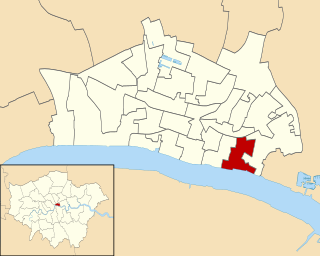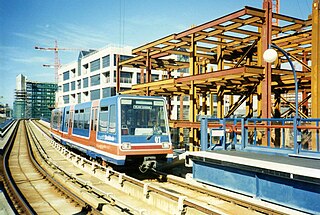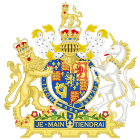
Smithfield, properly known as West Smithfield, is a district located in Central London, part of Farringdon Without, the most westerly ward of the City of London, England.

Barking is a riverside town in East London, England, within the London Borough of Barking and Dagenham. It is 9.3 miles (15 km) east of Charing Cross, bordered by Ilford to the North, Dagenham to the East and East Ham, London to the West. The total population of Barking was 59,068 at the 2011 census. In addition to an extensive and fairly low-density residential area, the town centre forms a large retail and commercial district, currently a focus for regeneration. The former industrial lands to the south are being redeveloped as Barking Riverside.

Billingsgate is one of the 25 Wards of the City of London. This small City Ward is situated on the north bank of the River Thames between London Bridge and Tower Bridge in the south-east of the Square Mile.

The London Docklands Development Corporation (LDDC) was a quango agency set up by the UK Government in 1981 to regenerate the depressed Docklands area of east London. During its seventeen-year existence, it was responsible for regenerating an area of 8.5 square miles (22 km2) in the London Boroughs of Newham, Tower Hamlets and Southwark. LDDC helped to create Canary Wharf, Surrey Quays shopping centre, London City Airport, ExCeL Exhibition Centre, London Arena and the Docklands Light Railway, bringing more than 120,000 new jobs to the Docklands and making the area highly sought after for housing. Although initially fiercely resisted by local councils and residents, today it is generally regarded as having been a success and is now used as an example of large-scale regeneration, although tensions between older and more recent residents remain.

Sir Horace Jones was an English architect particularly noted for his work as architect and surveyor to the City of London from 1864 until his death. He served as president of the Royal Institute of British Architects from 1882 until 1884, and was knighted in 1886. His most recognised work, Tower Bridge, was completed posthumously.

Old Billingsgate Market is the name given to what is now a hospitality and events venue in the City of London, based in the Victorian building that was originally Billingsgate Fish Market, the world's largest fish market in the 19th century.

New Spitalfields Market is a fruit and vegetable market on a 31-acre (13 ha) site in Leyton, London Borough of Waltham Forest in East London. The market is owned and administered by the City of London Corporation. The market is Europe's leading horticultural market specialising in exotic fruit and vegetables - and the largest revenue earning wholesale market in the UK.

New Covent Garden Market in Nine Elms, London, is the largest wholesale fruit, vegetable and flower market in the United Kingdom. It covers a site of 57 acres (23 ha) and is home to about 200 fruit, vegetable and flower companies. The market serves 40% of the fruit and vegetables eaten outside of the home in London, and provides ingredients to many of London's restaurants, hotels, schools, prisons, hospitals and catering businesses.

The Metropolitan Cattle Market, just off the Caledonian Road in the parish of Islington was built by the City of London Corporation and was opened in June 1855 by Prince Albert. The market was supplementary to the meat market at Smithfield and was established to remove the difficulty of managing live cattle at that latter site.

Dagenham Dock is an industrial district in the London Borough of Barking and Dagenham in London, England. It is located to the south of Dagenham and is on the River Thames. It was once the site of a large coaling port and continues to be the location of a small terminal licensed to handle coal off-loading. Today the site is used for a number of river-related operations including a 25-acre (100,000 m2) TDG depot with around 200 tanks for the storage of petrol, distillates, aviation fuel, biofuels, tallow, ethanol, fertilisers, and urea.

Charterhouse Street is a street on the north side of Smithfield in the City of London. The road forms part of the City’s boundary with the neighbouring London Boroughs of Islington and Camden. It connects Charterhouse Square and Holborn Circus, crossing Farringdon Road and running along a number of historical sites, including Smithfield Market.

Hungerford Market was a produce market in London, at Charing Cross on the Strand. It existed in two different buildings on the same site, the first built in 1682, the second in 1832. The market was first built on the site of Hungerford House, next to Durham Yard, the town house of the Hungerford family. The house had burned down in 1669 as is recorded in the Diary of Samuel Pepys. It was replaced by a new Italianate market building by Charles Fowler, which opened in 1833. The new market was unsuccessful. It was damaged when the adjoining Hungerford Hall burned down in 1854, and was sold to the South Eastern Railway in 1862. Charing Cross railway station was built on the site and opened in 1864.

St George Botolph Lane was a church off Eastcheap, in the ward of Billingsgate in the City of London. The rear of the church overlooked Pudding Lane, where the fire of London started. It was first recorded in the twelfth century, and destroyed in the Great Fire of 1666. It was one of the 51 churches rebuilt by the office of Sir Christopher Wren. The church was demolished in 1904.

Barking Power Station refers to a series of power stations at various sites within the London Borough of Barking and Dagenham in east London. The original power station site, of the coal-fired A, B and C stations, was at River Road, Creekmouth, on the north bank of the River Thames. These stations were decommissioned by 1981 and were subsequently demolished. The later gas-fired power station was built further down the Thames near Dagenham Dock in the early 1990s. The site of the former power stations is being redeveloped as Barking Riverside.

St Botolph's, Billingsgate was a Church of England parish church in London. Of medieval origin, it was located in the Billingsgate ward of the City of London and destroyed by the Great Fire of London in 1666.

Traffic Light Tree is a public sculpture in between Poplar and Blackwall, London, England, created by the French sculptor Pierre Vivant following a competition run by the Public Art Commissions Agency for the London Docklands Development Corporation under their Public Art programme. Originally situated on a roundabout in Limehouse, near Canary Wharf and Millwall, at the junction of Heron Quay, Marsh Wall and Westferry Road, it is now located on a different roundabout near Billingsgate Market in Poplar.

James Bunstone Bunning was an English architect. He held the post of architect to the City of London from 1843 until his death, and is probably best remembered for his design for the Coal Exchange.

The London Coal Exchange was situated on the north side of Thames Street in the City of London, nearly opposite to Old Billingsgate Market, occupying three different structures from 1770 to 1962. The original coal exchange opened in 1770. A second building from 1805 was replaced by a new purpose-built structure constructed from 1847 to 1849, and opened by Prince Albert on 30 October 1849. This third London coal exchange was one of the first substantial buildings constructed from cast iron, built several years before the hall at the Great Exhibition. It was demolished in 1962 to allow widening of what is now Lower Thames Street despite a campaign by the Victorian Society to save the building. Cast iron decorations from the 1849 Coal Exchange building were selected as the model for the dragon boundary mark for the main entrances to the City of London.
Botolph Wharf or St Botolph's Wharf was a wharf located in the City of London, on the north bank of the River Thames a short distance downstream from London Bridge. It was situated between Cox and Hammond's Quay upstream and Nicholson's Wharf downstream. On the landward side, the wharf was accessed via Thames Street. It had a frontage of 78 ft (24 m). The wharf was used for at least a thousand years before being destroyed during the Second World War. A late 1980s office building currently occupies the site.
























